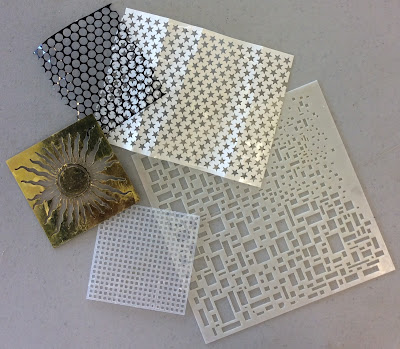The October FOG
Tuesday was spent experimenting with the application of dimensional molding or
modeling pastes on fabrics and other substrates. Depending on the brand used, these
pastes are called by different names.
These are a few that
we tried:
- Golden™ – HeavyGel Matte
- Golden™ – Coarse Modeling Paste
- Golden™ – Fine Pumice Gel
- Liquitex™ –Modeling Light Paste
- DAP DryDexSpackle™
- Poly Filla™ (dry powder in the box)
- Easi-Fil Drywall Compound™
- Elmer’s White Glue ™
- Mixtures of the white glue, Poly Filla™, and Easi-Fil™ Drywall Compound
The key word to look for in the description of the products
is “flexible”. Several of the
products cracked when the fabric was folded. Some of my samples have cracked but
have not flaked off the fabrics. The more flexible the product remains on your
fabric, the more it will accept hand or machine stitching.
We also tried a variation of a mix suggested in Stitch with the Embroiders’ Guild Magazine.
This consisted of Poly Filla™,
white acrylic house paint/primer and white glue. We finally decided on a
mixture of drywall compound, Poly Filla™
and white glue as the mixture that added some flexibility to the drywall
compound. We did not really see the need to add the white paint, as it diluted
the solution too much. The Poly Filla™
was useful in making the mixture the right consistency, as the white glue also
thinned out the drywall compound. While this did work, you need to mix it and
use it the same day as it tends to harden overnight. A couple of our members
found that by mixing this compound with a runnier gel medium that it worked
quite well.
Any of these
products can be mixed with a colourant. We tried inks, walnut ink, craft
acrylic paint and Lumiere™ paints to name a few. Remember that any liquid will change the consistency of the product, so
start with a light hand.
To apply the
products to the fabrics you will need a credit card to squeegee the product
through your stencil of choice, commercial or hand cut. Thermofax™ screens DO
NOT work. Be certain to have a dishpan of water nearby so that you can put your
stencils in right after use so that the products do not dry as the stencils could
be permanently damaged.
Below you can
see several items that we used as stencils.
 |
| Brass dry embossing stencils, sequin waste, commercial stencil, plastic canvas. |
You can also use
ConTact™ paper masks as a stencil. We cut the stencils using Jan’s Sizzix Big
Shot™. You will get both a positive and a negative stencil to use. Peel the
backing off the mask and place sticky side down onto your fabric. Lay a stencil
over the mask (sequin waste works well) and draw the product over the stencil
with a credit card. It also worked well to lay down the
sequin waste, and then use a stencil over top of that.
 |
| Sizzix Big Shot, ConTact Paper stencil, positive and negative ConTact paper stencils. |
We also tried spreading the mixture over hand stitching, and
also stamping into it. These created some very unique textures. The stitching
was visible through the compound, but more subdued. The stamps did not produce
a clear imprint, but definitely created additional texture. Again, remember to
immediately wash your stamp.
We tried this
process on a number of different fabrics and they all appeared to take the
product quite well.
These are a few
that we tried:
- Decorator fabric samples (finally a use for some of the 400 I have sitting in my hall)!
- Cotton Canvas
- Acrylic Felt
- Interfacing
- Lutradur
- Burlap
- Cotton
- Timex
- Hard paint canvas
 |
| Diane's on Black Interfacing, Margaret's on Decorator Fabric Sample, Gillian's on Lutradur-like Fabric. |
Modeling/molding paste is certainly one way to add texture
to your artwork. The ease of colouring it with inks and paints makes it easy to
use, and gives you lots of options for adding it. There were lots of
possibilities suggested to take this technique further!
